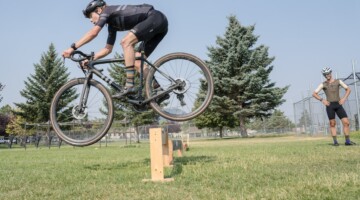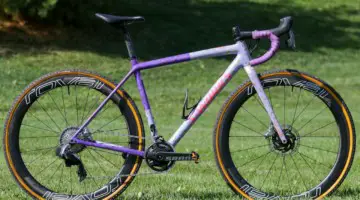by Justin Christopher
SRAM’s New XPLR Components – Are They Right for Your Cyclocross or Gravel Bike?
SRAM – the parent company of Avid, Rockshox, and Zipp – has announced the release of their new XPLR (pronounced “explore”) component line intended for riding drop bar bikes in the dirt. The new XPLR series includes a short-travel suspension fork, called Rudy, as well as a dropper seatpost from suspension brand Rockshox; a matching carbon disc gravel wheelset from Zipp, and new eTap electronic, wireless shifting drivetrain options under the existing SRAM AXS Force, Red, and Rival labels.
SRAM’s XPLR Components Are for Riding Drop Bars on Dirt
These new components reflect SRAM’s increasing focus on the booming gravel bike market. Direct competitor Shimano’s GRX groupsets are also an attempt to directly address this need – drop bar bikes with hydraulic disc brakes for riding in the dirt, with wide-range drivetrain options for steep hills, bikepacking, and other applications. Unlike SRAM’s road-focused AXS eTap gear, (as well as Shimano’s GRX double chainring option) the new XPLR line is a single chainring, “1x” specific for gravel riders who want to skip the front derailleur.
As with modern road bike components, many parts designed for drop-bar gravel riding are a natural fit for cyclocross racing too. Does the new XPLR line belong on your cyclocross or gravel bike? Let’s take a look at the new products and go beyond the press release to see what fits where.
Zipp 101 XPLR Wheelset
The Zipp 101 XPLR wheelset uses a wide, carbon fiber hookless rim, and centerlock disc brake hubs to form the basis of Zipp’s first dedicated gravel wheelset. The new rim offers a 27mm internal width, to better support the use of wide, high air volume gravel and adventure tires.

The new SRAM / Rock Shox / Zipp XPLR gravel group.
Zipp’s big selling point here isn’t aerodynamics, it’s reduced fatigue on epic, all-day gravel rides. This is a departure from their previous wheels and shows the benefits of a dedicated, gravel-specific design as opposed to re-purposing a road wheel. Zipp calls the new technology MOTO, which “allows the rim to pivot from either side of the spoke bed while traversing rough terrain” for reduced chance of a puncture and improved traction. As someone who has suffered from elbow tendonitis aggravated by bumpy dirt roads in the past, it sounds very promising. Ultra-stiff frames, forks, and wheels can beat the rider up, so it’s refreshing to see a new product focused on comfort instead.
It’s also great to see SRAM / Zipp embracing the centerlock disc brake rotor mounting system. This makes it easy to swap rotors or remove them for safer transport and is far more convenient than 6-bolt rotors and hubs.
Zipp also acknowledges that riders may still want the new wheels without completely buying into the XPLR system, so they are available with Shimano-compatible freehub bodies as well as the SRAM XDR driver – a nice touch for riders with Shimano shifting.
The knock against these wheels will be the weight. At 1,620 grams a set, there are lighter options available for the racing crowd. For gravel exploring, bikepacking, and other applications where durability and comfort are more important than weight (when you can’t afford to break down in the middle of nowhere), they are more than competitive.
I’m 100% sold on hookless rims and high-volume, wide tires for gravel riding. The jury is still out on the use of hookless rims for cyclocross, though. Even traditional hook bead tubeless rims and tires can still burp air under aggressive riders, depending on the selected rim/tire combo; additionally, the recommended width tires for the 101 wheelsets are 38-45mm, which is too big for serious cyclocross racers. Cyclocross demands extremely low tire pressures that fall below the recommended PSI for most hookless rim brands. Today, cyclocross racers are probably better served by tubular tires and rims, or a traditional hook bead tubeless rim designed around narrower tires.
Recommendation: looks great for gravel, but skip them for cyclocross.
SRAM XPLR Drivetrain
All the XPLR components revolve around SRAM’s AXS (“access”) wireless shifting. This is the same wireless shifting, hydraulic brake system we’ve seen previously, with a couple of key changes:
- 3 new rear derailleurs: Rival, Force, and Red, each specific to 1x drivetrains and intended for use with 10-44 cassettes
- 2 new 12-speed cassettes, Force and Red levels, in 10-44 teeth
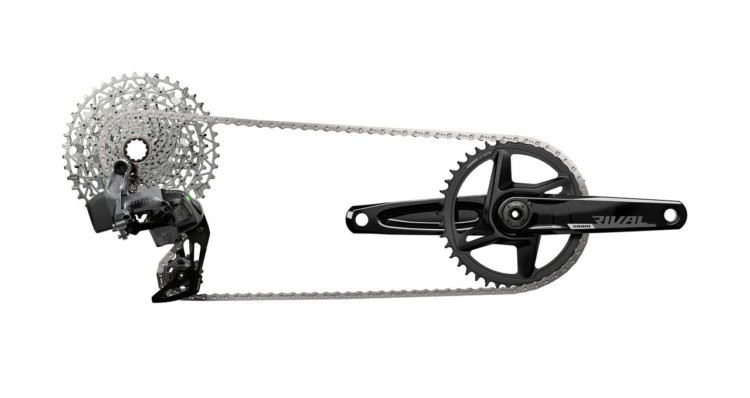
The new SRAM / Rock Shox / Zipp XPLR gravel group.
If you’ve already ridden a recent AXS eTap bike with wireless shifting, you already know how this works – the line has just been updated with new rear derailleurs, optimized for single chainring gravel bikes, and wide-range 10-44 cassette choices.

The new SRAM / Rock Shox / Zipp XPLR gravel group.
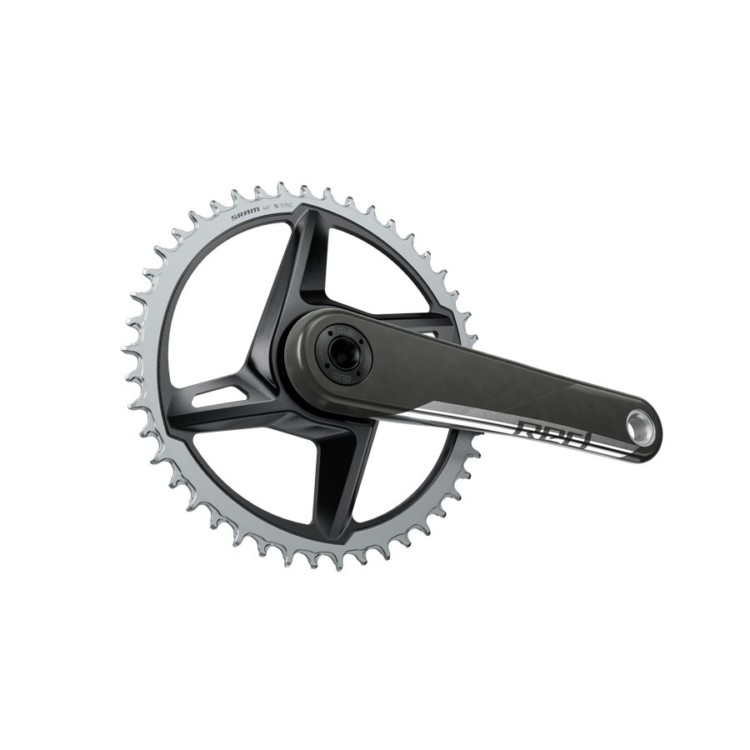
The new SRAM / Rock Shox / Zipp XPLR gravel group.
I must say that SRAM is hitting a home run with the cross-compatibility of their parts. Riders are already mixing up the 10-50 Eagle “MTB” cassettes, flat bars, drop bars, and the new cassettes offer even more options. With the single chainring setup, it’s pretty easy to run the new 10-44 cassette and something like a 40 tooth chainring as a cyclocross race setup for a huge gear range with no front derailleur required. Do note: these cassettes are only offered in SRAM’s XDR driver body, so you’ll need a matching rear hub.

The new SRAM / Rock Shox / Zipp XPLR gravel group.
If there’s a downside, the rear derailleurs are spendy, especially at the top end: $255, $350, and $710 for Rival, Force, and Red, respectively, and that doesn’t include the battery, which is an additional $55.

The new SRAM / Rock Shox / Zipp XPLR gravel group.
For a gravel or cyclocross bike that gets dirty and abused, I wouldn’t bother with the Red derailleur – damaging a rear derailleur in cyclocross is common, so the Rival eTap AXS 1x model looks compelling for that use.

The new SRAM / Rock Shox / Zipp XPLR gravel group.
Recommendation: a must-do for your next ‘cross or gravel bike! I love how the lack of cables makes it easier to keep bikes equipped with SRAM AXS drivetrains clean, and there are no mechanical cables to fill up with sand if you drop the bike.
Rockshox Rudy XPLR Fork
Readers of a certain age will recall the Rockshox Ruby (not Rudy) suspension forks that were used for cobbled road races, like Paris-Roubaix. They came and went, not finding a permanent home in the peloton. If you close your eyes and squint, you can sort of imagine the new Rudy looking like an old Rockshox Mag-21 from the 1990s. We’ve seen Fox release a gravel-oriented fork, and now Rockshox has an answer.
It is of course completely modernized: options for 30 or 40mm of travel, a new lightweight damper, thru-axle, flat mount disc brakes, and it’s even E-Bike approved in case you want to add some comfort and control to a gravel E-Bike! It accepts fenders for bad weather riding and offers clearance for 50mm tires.
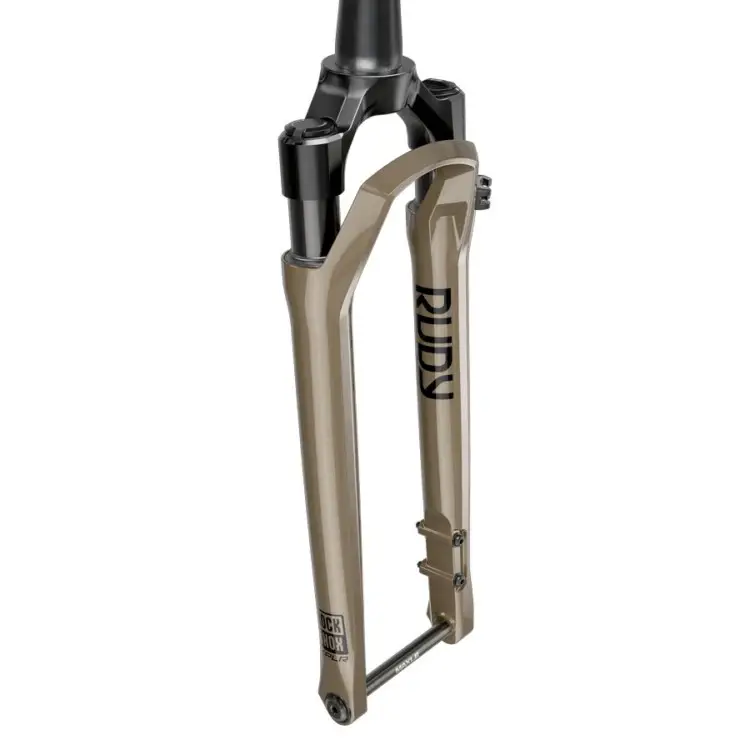
The new SRAM / Rock Shox / Zipp XPLR gravel group.
So, will we see short-travel suspension forks on cyclocross bikes? Perhaps as a novelty factor, occasionally used by an athlete who leans to the bleeding edge on courses where it makes sense, but I don’t see widespread adoption. There’s simply too much weight penalty in a sport where athletes run with the bike on their shoulder.
On the gravel side, you’ll likely see complete bikes featuring the Rudy fork hit the market. The axle-to-crown measurement on this fork is an inch longer than the ENVE and Whisky forks commonly found on current gravel and cyclocross bikes, so retrofitting a Rudy isn’t necessarily a perfect fit. It might be better to use a frame with geometry specifically designed for the Rudy suspension fork.

The new SRAM / Rock Shox / Zipp XPLR gravel group.
At 1,200+ grams, you’re paying about a 700-800 gram penalty compared with the rigid carbon forks on race bikes, and 600 grams or so vs. an “adventure” fork. That might be a reasonable trade-off for riders who want to focus on comfort during super-endurance events. Strangely, there is no 650b wheel size option – 700c only for now.
Recommendation: exciting for gravel riders on bumpy terrain, but doesn’t make sense for most cyclocross riders or gravel riders on smoother roads.
Rockshox Reverb AXS XPLR Suspension Dropper Seatpost
The new Reverb AXS XPLR is clever, incorporating both a suspension seat post and a dropper function into a single design. It’s one of my favorite parts of the new XPLR line.
With today’s bikes being lighter than ever I don’t mind a small weight penalty in exchange for convenience or comfort. In addition to the dropper function, the XPLR seatpost also includes a small amount of suspension. At full height, it’s locked out for pedaling efficiency; drop the post on steep, tricky terrain, and in addition to the saddle moving out of the way you also get some suspension.
Like the AXS wireless shifting, the Reverb AXS XPLR suspension dropper seat post is powered by the same (interchangeable) rechargeable battery. Yes, it’s one more thing to charge, but since it’s cross-compatible with the AXS derailleurs, having a few extras around isn’t a big deal.

The new SRAM / Rock Shox / Zipp XPLR gravel group.
The rider activates the dropper post through the handlebar-mounted eTap buttons. It’s seamless and convenient and with no cable to be routed works on a huge variety of frames. Installation is trivial compared to the complexity of dropper posts that require a cable to be routed along the exterior or inside the frame tubes. Wireless is so much cleaner!
It’s worth noting that the post is only offered in 27.2mm. While that’s the most common size, it does exclude some bikes that use a larger diameter.
Recommendation: give it a whirl for challenging gravel terrain. I’d definitely consider the Reverb AXS XPLR dropper when spec’ing out a new bike or replacing an existing seatpost.
XPLR Tires and Handlebars
Not to be missed in the press release are a few other goodies – Zipp branded gravel tires called G40 XPLR, and a new flared version of Zipp’s Service Course SL-70 drop handlebar. This is the bar I’ve spec’d on all my most recent builds, it is competitively priced, lightweight, and has proven durable. I like aluminum handlebars for cyclocross instead of carbon, so it’s easy to recommend these.

The new SRAM / Rock Shox / Zipp XPLR gravel group.
At $65, the tire looks similar to offerings from Donnelly, Maxxis, and Kenda. One reason to choose it might be if you plan to use the hookless Zipp 101 XPLR wheelset – with both the tire and the rim coming from Zipp, better tire/rim compatibility might result.

The new SRAM / Rock Shox / Zipp XPLR gravel group.
SRAM XPLR Availability
This stuff hits the market in August, September, and October of 2021. So you’re cutting it pretty close if you’re waiting on this before building up your cyclocross bike for the Fall racing season. In practice, you’re probably looking at 2022 before there is widespread general availability.
There’s also the option to buy complete bikes, off-the-shelf, equipped with XPLR – popular brands like Canyon, Cervelo, and Cube having already announced new models. This may be a faster way to get an XPLR-equipped ride.
Modern Gravel Bikes Look Increasingly Like 1990’s Mountain Bikes
With wider tires, and the addition of a short-travel suspension fork, today’s modern gravel bike is beginning to look a lot like a 1990’s MTB. And that’s OK! The difference is we now have brakes that work great without cramping your hands, electronic shifting with huge gear ranges, dropper seatposts, and a bike that’s 10 lbs lighter. Win!
This Article Was Brought to You Via a Partnership Between Cyclocross Magazine and RideCX.com
RideCX offers everything cyclocross and gravel riders need – tires, sealant, tools, and more, along with expert guidance and fast, free shipping on orders $50 and up. New customers can get $5 off their first purchase.

